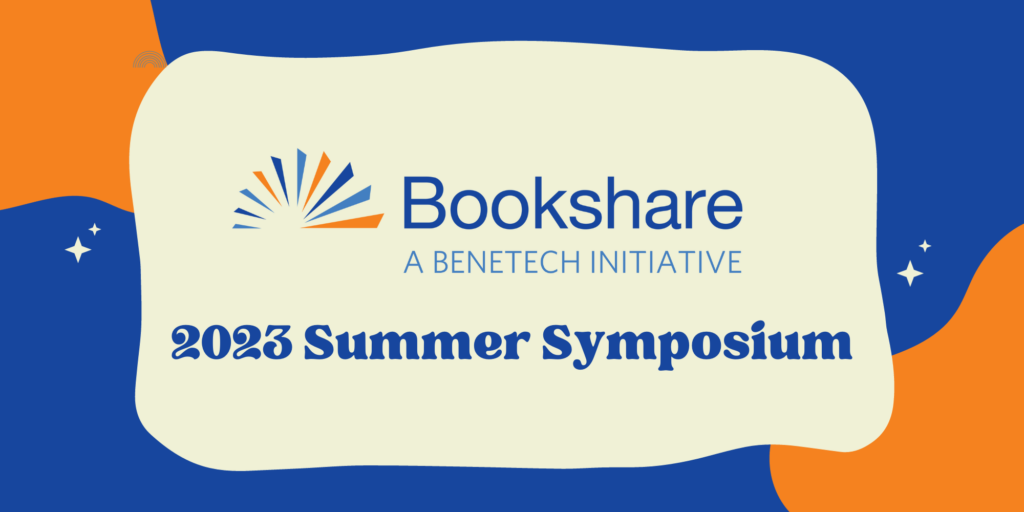Bookshare Summer Symposium 2023 Highlights: Giving Our Students Choice and Voice

Enjoy our rundown of this year’s Bookshare Summer Symposium, highlighting the experts, educators, and students who shared at July’s event.
We want our educational practice to level the playing field, be interdisciplinary, and be transformational. With this message, the 2023 Bookshare Summer Symposium began with an enlightening keynote focused on project-based learning by Jim Vanides, education consultant and Benetech Advisory Board member. Event attendees then spent the day learning more about disability and accessibility-focused topics and how to involve student voice and expertise in these practices.
At the symposium, we learned from experts, educators, and students across the country as they shared topics like Universal Design for Learning (UDL), creating equitable schools and classrooms, student advocacy, cultural responsiveness, and implementing Bookshare.
Providing Voice and Choice for Students
Megan Shanley and Jennifer Armstrong from New Mexico UDL and Kelli Suding from CAST shared about the importance of UDL and creating accessible and equitable spaces for our students.
Providing multiple means of engagement, representation, action, and expression for a student accomplishes many goals:
- – Students are allowed voice and choice in the decisions being made about their education
- – Students develop a greater understanding of their own strengths
- – Students become more resourceful and knowledgeable
This can look like accepting a video submission instead of an essay, completing an experiment, not a worksheet, or drawing a representation of a student’s understanding.
As educators, we are concerned about access for all – this is not a one-and-done endeavor. We must consider accessibility and UDL from start to finish in everything from the classroom and school environment to actual instruction.
“The more you give voice and choice, the more you engage your students, the more their actual brain starts to change.” – Megan Shanley, OT/ATP, New Mexico CREC
Video: Universal Design for Learning and Creating Your Equitable Classroom
How Does Accessibility and Equity Help Your Students?
In addition to our presenters above, we were joined by Bookshare Student Champions, Dr. Kim Lanoy-Sandoval from Future Focused Education, and Bookshare Outreach Coordinators to share about student voice and equity in a classroom.
Remember that no two brains are alike; they are as unique as our thumbprints. So, we need to make sure that we respect these ideas and encourage choice and voice in our classroom while trying to remove barriers for our students. These barriers can be cultural, physical, instructional, or emotional. When thinking about our students with print disabilities, they often come to us not reading or writing on grade level. What can we do to help them access the content?
Our student panelists repeatedly highlighted how asking them for their opinions and knowledge, as these decisions are being made about their education. Making a plan with and not for them makes them feel safe, seen, and heard. The aim should be returning power and autonomy back to our students. Ensure lines of communication stay open with your students and that you don’t assume competency or achievement based on appearance to ensure these goals are being met.
Safety in a classroom and school is also built by fully accepting, valuing, and affirming your students’ culture and background, accepting students as their whole selves. Cultural responsiveness is more than assimilation—accepting, honoring, respecting, sharing, and engulfing our presence in each culture. We don’t want students to shed their identity to be accepted into a learning community, whether that identity is their culture, family background, or the presence of a disability. Challenge yourself to better understand intersectionality and the systems in place in our school systems, then build that knowledge into the classroom environment.
Video: Cultural Responsiveness in the Classroom
Implementing Bookshare at Your School
Three of our Bookshare Teacher Champions joined us to discuss how they implement Bookshare in their school and shared their best tips.
- – Give educators and students agency – teachers know their students best.
- – Ensure that students take time to go through all setting options in their reader of choice, like the Bookshare Reader for Web or Mobile Reader. This customization can make or break the reading experience for a student.
- – Encourage students to add the Individual Membership with permission from their parent. Students become good readers by reading at home!
- – Make sure you consider all students and their eligibility for Bookshare. These educators outlined reviewing every student with a Specific Learning Disability with reading checked as an area of concern on their IEP. While this does not encompass all qualifications for Bookshare, it does help ensure they reach more students who qualify.
- – Reading lists are important for giving choices to students! Creating reading lists for your organization allows students to access more books and fosters a love for reading.
“The greatest predictor of reading growth is time spent reading!” – Kelli Suding
Video: Implementing Bookshare at Your School
Tools to Engage Students and Provide Choice
- – Sign Up for Bookshare!
- – Handouts Shared at the Symposium: New Mexico UDL, CAST
- – Identify Reading Accomodations: UPAR
- – Math Accessibility: Equatio
- – Video Tools: Seesaw or Flip
- – PATINS Interactive Classroom
Watch the 2023 Bookshare Symposium On-Demand
Playlist: 2023 Bookshare Summer Symposium
We hope you can join next year’s Bookshare Summer Symposium to continue learning from our incredible community about accessibility, access, and equity! Don’t take our word for it!
“We need more of these type of trainings/PD/staffing in our own campus. This has been the highlight of my summer. I’m excited to start the school year now.” – Bookshare Summer Symposium 2023 Attendee
